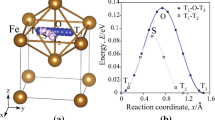Abstract
In this work, the process of the formation of defects and their clusters in collision cascades has been investigated in molybdenum by the molecular dynamics method. We have obtained results on the number of arising defects, the fraction of defects in clusters, and cluster-size distribution. Their dependence on the energy of primary knocked-on atom and temperature of the material has been studied. A comparison with calculations using the SRIM program and NRT model has been made. The effect of annealing defects after the development of cascades on the number of arising defects has been examined.
Similar content being viewed by others
References
D. Xu, B. D. Wirth, M. Li, and M. A. Kirk, “Combining in situ transmission electron microscopy irradiation experiments with cluster dynamics modeling to study nanoscale defect agglomeration in structural metals,” Acta Mater. 60, 4286–4302 (2012).
A. Gokhman and F. Bergner, “Cluster dynamics simulation of point defect clusters in neutron irradiated pure iron,” Radiat. Eff. Defects Solids: Incorpor. Plasma Sci. Plasma Technol. 165, 216–226 (2010).
R. E. Stoller, G. R. Odette, and B. D. Wirth, “Primary damage formation in bcc iron,” J. Nucl. Mater. 25, 49–60 (1997).
L. Malerba, “Molecular dynamics simulation of displacement cascades in α-Fe: A critical review,” J. Nucl. Mater. 351, 28–38 (2006).
M. Yu. Romashka and A. V. Yanilkin, “Simulation of the low-temperature stage of annealing of radiation defects in bcc iron using the molecular dynamics method,” Phys. Met. Metallogr. 115, 965–972 (2014).
S. V. Starikov, “Atomistic simulation of the process of defect formation in uranium dioxide during fission fragments flying through,” High Temper. 53, 55–61 (2015).
A. P. Selby, D. Xu, N. Juslin, N. A. Capps, and B. D. Wirth, “Primary defect production by high energy displacement cascades in molybdenum,” J. Nucl. Mater. 437, 19–23 (2013).
G. J. Ackland and R. Thetford, “An improved N-body semi-empirical model for body-centered cubic transition metals,” Philos. Mag. 56, 15–30 (1987).
S. V. Starikov, Z. Insepov, J. Rest, A. Yu. Kuksin, G. E. Norman, V. V. Stegailov, and A. V. Yanilkin, “Radiation induced damage and evolution of defects in Mo,” Phys. Rev. B: Condens. Matter Mater. Phys. 84, 104109 (2011).
J. F. Ziegler, J. P. Biersack, and U. Littmark, The Stopping and Range of Ions in Solids (Pergamon, New York, 1985).
Z. Insepov, J. Rest, A. Yacout, A. Yu. Kuksin, G. E. Norman, V. V. Stegailov, S. V. Starikov, and A. V. Yanilkin, “Derivation of kinetic coefficients by atomistic methods for studying defect behavior in Mo,” J. Nucl. Mater. 425, 41–47 (2012).
A. Yanilkin, Z. Insepov, G. Norman, J. Rest, and V. Stegailov, “Atomistic simulation of clustering and annihilation of point defects in molybdenum,” Defect Diffus. Forum 323–325, 95–100 (2012).
M. J. Norgett, M. T. Robinson, and I. M. Torrens, “A proposed method of calculating displacement dose rates,” Nucl. Eng. Des. 33, 50–54 (1975).
C. H. M. Broeders and A. Yu. Konobeyev, “Defect production efficiency in metals under neutron irradiation,” J. Nucl. Mater. 328, 197–214 (2004).
M. Li, M. Eldrup, T. S. Byun, N. Hashimoto, L. L. Snead, and S. J. Zinkle, “Low temperature neutron irradiation effects on microstructure and tensile properties of molybdenum,” J. Nucl. Mater. 376, 11–28 (2008).
Author information
Authors and Affiliations
Corresponding author
Additional information
Original Russian Text © A.Yu. Kuksin, A.V. Yanilkin, 2016, published in Fizika Metallov i Metallovedenie, 2016, Vol. 117, No. 3, pp. 242–249.
Rights and permissions
About this article
Cite this article
Kuksin, A.Y., Yanilkin, A.V. Formation of Defects in Displacement Cascades in Molybdenum: Simulation of Molecular Dynamics. Phys. Metals Metallogr. 117, 230–237 (2016). https://doi.org/10.1134/S0031918X1602006X
Received:
Accepted:
Published:
Issue Date:
DOI: https://doi.org/10.1134/S0031918X1602006X




